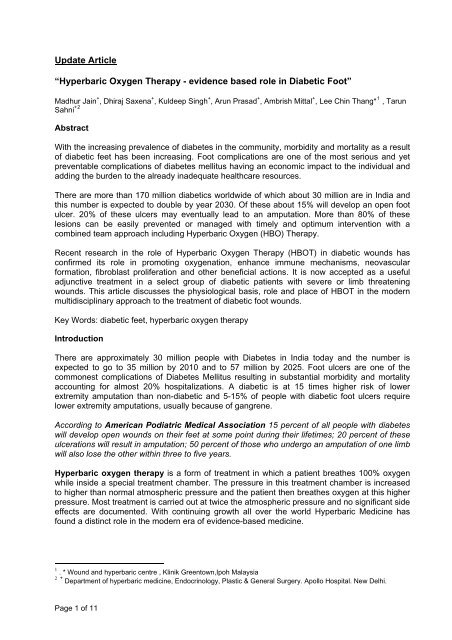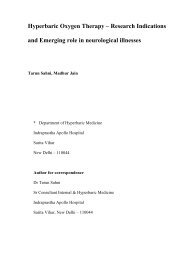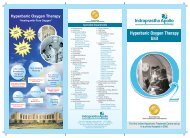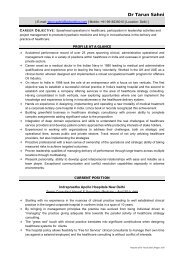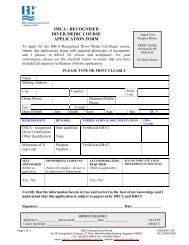Hyperbaric Oxygen Therapy: A modern ... - Hyperbaric India
Hyperbaric Oxygen Therapy: A modern ... - Hyperbaric India
Hyperbaric Oxygen Therapy: A modern ... - Hyperbaric India
Create successful ePaper yourself
Turn your PDF publications into a flip-book with our unique Google optimized e-Paper software.
Update Article<br />
“<strong>Hyperbaric</strong> <strong>Oxygen</strong> <strong>Therapy</strong> - evidence based role in Diabetic Foot”<br />
Madhur Jain + , Dhiraj Saxena + , Kuldeep Singh + , Arun Prasad + , Ambrish Mittal + , Lee Chin Thang* 1 , Tarun<br />
Sahni +2<br />
Abstract<br />
With the increasing prevalence of diabetes in the community, morbidity and mortality as a result<br />
of diabetic feet has been increasing. Foot complications are one of the most serious and yet<br />
preventable complications of diabetes mellitus having an economic impact to the individual and<br />
adding the burden to the already inadequate healthcare resources.<br />
There are more than 170 million diabetics worldwide of which about 30 million are in <strong>India</strong> and<br />
this number is expected to double by year 2030. Of these about 15% will develop an open foot<br />
ulcer. 20% of these ulcers may eventually lead to an amputation. More than 80% of these<br />
lesions can be easily prevented or managed with timely and optimum intervention with a<br />
combined team approach including <strong>Hyperbaric</strong> <strong>Oxygen</strong> (HBO) <strong>Therapy</strong>.<br />
Recent research in the role of <strong>Hyperbaric</strong> <strong>Oxygen</strong> <strong>Therapy</strong> (HBOT) in diabetic wounds has<br />
confirmed its role in promoting oxygenation, enhance immune mechanisms, neovascular<br />
formation, fibroblast proliferation and other beneficial actions. It is now accepted as a useful<br />
adjunctive treatment in a select group of diabetic patients with severe or limb threatening<br />
wounds. This article discusses the physiological basis, role and place of HBOT in the <strong>modern</strong><br />
multidisciplinary approach to the treatment of diabetic foot wounds.<br />
Key Words: diabetic feet, hyperbaric oxygen therapy<br />
Introduction<br />
There are approximately 30 million people with Diabetes in <strong>India</strong> today and the number is<br />
expected to go to 35 million by 2010 and to 57 million by 2025. Foot ulcers are one of the<br />
commonest complications of Diabetes Mellitus resulting in substantial morbidity and mortality<br />
accounting for almost 20% hospitalizations. A diabetic is at 15 times higher risk of lower<br />
extremity amputation than non-diabetic and 5-15% of people with diabetic foot ulcers require<br />
lower extremity amputations, usually because of gangrene.<br />
According to American Podiatric Medical Association 15 percent of all people with diabetes<br />
will develop open wounds on their feet at some point during their lifetimes; 20 percent of these<br />
ulcerations will result in amputation; 50 percent of those who undergo an amputation of one limb<br />
will also lose the other within three to five years.<br />
<strong>Hyperbaric</strong> oxygen therapy is a form of treatment in which a patient breathes 100% oxygen<br />
while inside a special treatment chamber. The pressure in this treatment chamber is increased<br />
to higher than normal atmospheric pressure and the patient then breathes oxygen at this higher<br />
pressure. Most treatment is carried out at twice the atmospheric pressure and no significant side<br />
effects are documented. With continuing growth all over the world <strong>Hyperbaric</strong> Medicine has<br />
found a distinct role in the <strong>modern</strong> era of evidence-based medicine.<br />
1 . * Wound and hyperbaric centre , Klinik Greentown,Ipoh Malaysia<br />
2 + Department of hyperbaric medicine, Endocrinology, Plastic & General Surgery. Apollo Hospital. New Delhi.<br />
Page 1 of 11
Physiological basis of HBO therapy<br />
When we normally breathe air at sea level pressure, Hb is 95% saturated with oxygen (O 2 ) and<br />
100 ml blood carries 19 ml O 2 combined with Hb and 0.32 ml dissolved in plasma. At this same<br />
pressure if 100% O 2 is inspired, O 2 combined with Hb<br />
increases to a maximum of 20 ml and that dissolved in<br />
plasma to 2.09 ml. Most tissue needs of <strong>Oxygen</strong> are<br />
met from the O 2 combined to Hb.<br />
The higher pressure during hyperbaric oxygen<br />
treatment pushes more <strong>Oxygen</strong> into solution and<br />
amount of O 2 dissolved in plasma increases to 4.4<br />
ml/dl at a pressure of 2 ATA and to 6.8 ml/dl at 3 ATA.<br />
This additional <strong>Oxygen</strong> in solution is almost sufficient<br />
to meet tissue needs without contribution from oxygen<br />
bound to hemoglobin and is responsible for most of<br />
the beneficial effects of HBO therapy.<br />
Therapeutic effects of HBO <strong>Therapy</strong><br />
<br />
<br />
Table 1 : Effect of Pressure on Arterial O2<br />
Total<br />
Pressure<br />
Content of <strong>Oxygen</strong><br />
Dissolved in plasma (vol<br />
%)<br />
ATA MmH<br />
g<br />
Breathing<br />
Air<br />
100%<br />
<strong>Oxygen</strong><br />
1 760 0.32 2.09<br />
1.5 1140 0.61 3.26<br />
2 1520 0.81 4.44<br />
2.5 1900 1.06 5.62<br />
3 2280 1.31 6.80<br />
All values assume arterial pO 2 = alveolar O 2 and<br />
that Hb O 2 capacity of blood is 20 vol %<br />
Hyperoxygenation causes (i) Immune stimulation by restoring WBC function and enhance<br />
their phagocytic capabilities and (ii) Neo-vascularization in hypoxic areas by augmenting<br />
fibroblastic activity and capillary growth. This is useful in radiation tissue damage and other<br />
problem wounds.<br />
Vasoconstriction reduces edema and tissue swelling while ensuring adequate <strong>Oxygen</strong><br />
delivery and is thus useful in acute trauma wounds and burns.<br />
Bactericidal for anaerobic organisms & inhibits growth of aerobic bacteria at pressures ><br />
1.3 ATA. It Inhibits production of alpha-toxin by C Welchii and is synergistic with<br />
Aminoglycosides and Quinolones. Thus it is life saving in gas gangrene and severe<br />
necrotising infections.<br />
<br />
<br />
<br />
Reduces half-life of Carboxyhaemoglobin from 4 to 5 hours to 20 minutes or less and is<br />
the treatment of choice for Carbon Monoxide poisoning in fire victims.<br />
Mechanical effects: Direct benefit of Increased pressure helps reduces bubble size in Air<br />
Embolism and Decompression Illnesses.<br />
Reactivates “ sleeping cells ” in the penumbra region around central dead neuronal<br />
tissue and is the basis of use in neurological conditions. It also reduces adherence of<br />
WBCs to capillary walls and maybe useful in acute brain and spinal cord injury.<br />
Pathophysiology of Diabetic Foot<br />
Diabetic patients are extremely vulnerable to foot problems. Typically there is decreased<br />
circulation, decreased or absent sensation, loss of function of the small muscles of the foot and<br />
impaired ability to heal. A minor foot problem in a non-diabetic patient can be limb or life<br />
threatening in the diabetic patient. The personal and economic costs attached to this problem<br />
are staggering.<br />
The triad of peripheral neuropathy, Peripheral vascular disease and mechanical abnormality is<br />
the major contributing factor for Diabetic Foot Ulcers– other being infection, trauma and<br />
increased plantar pressure leading to ulceration. Approximately 60% of Diabetic Foot ulcers are<br />
primarily neuropathic, 20% are primarily ischemic and 20% are both neuropathic and ischemic.<br />
Peripheral neuropathy has a central role and affects 40-60% of diabetic population. In most<br />
cases, ulceration is a consequence of unnoticed injuries due to loss of protective sensation<br />
Page 2 of 11
(sensory neuropathy). Motor neuropathy causes intrinsic muscle atrophy and wasting leading to<br />
loss of stabilization force of the toes, resulting in contracture and foot deformities. Autonomic<br />
neuropathy leads to A-V shunting (resulting in islands of cutaneous ischemia) and loss of<br />
sweating mechanism. All these factors make foot vulnerable to injury and resulting ulcer and<br />
infection.<br />
Figure 1 : Aetiology of Diabetic Wounds<br />
Aetiology of Diabetic Wounds<br />
Angiopathy<br />
Neuropathy<br />
Macro Micro Autonomic Sensory Motor<br />
Loss of sensation<br />
Occlusion<br />
Dry gangrene<br />
Patchy<br />
atrophy of<br />
skin<br />
Ulceration<br />
Extensive<br />
spreading<br />
Decrease in<br />
perspiration<br />
Dry skin<br />
cracks and<br />
fisures<br />
Infection<br />
Gangrene<br />
Painless<br />
trauma:<br />
mechanical,<br />
thermal<br />
Ulceration<br />
Forefoot<br />
Bone and<br />
joint<br />
changes<br />
Treatment<br />
Healing<br />
Muscle<br />
atrophy<br />
Changes<br />
in gait<br />
Pressure<br />
points<br />
Amputation Leg Toes<br />
Peripheral Ischemia is another major factor leading to diabetic foot wounds. Peripheral vascular<br />
disease has been shown to be a pathogenic factor in 60% of diabetic patients with non-healing<br />
ulcers and 46% of those undergoing major amputation. Ischemia weakens local defenses<br />
against infection because of reduced blood flow and tissue supply in oxygen, essential nutrients<br />
and growth factors and thus plays a major role in delayed wound healing. In diabetics, PVD<br />
manifests primarily in the tibial and peroneal blood vessels.<br />
Infection is a frequent complication favored by neuropathy and ischemia. Its severity may range<br />
from a mild, localised infection to a limb-threatening necrotizing process with fasciitis. Beside<br />
these devastating infections leading often to amputation, bone and joint involvement has been<br />
shown to be a factor of delayed healing and subsequent amputation even when ischemia has<br />
been relieved by a revascularisation procedure.<br />
Classification of Diabetic Foot Wounds<br />
The well-established widely used Wagner wound classification system and the new University of<br />
Texas (UT) diabetic wound classification system both provide descriptions of ulcers to varying<br />
degrees. Both wound classification systems are easy to use among health care providers, and<br />
both can provide a guide to planning treatment strategies.<br />
The Wagner system assesses ulcer depth and the presence of osteomyelitis or gangrene by<br />
using the following grades: grade 0 (pre- or post-ulcerative lesion), grade 1 (partial/full thickness<br />
ulcer), grade 2 (probing to tendon or capsule), grade 3 (deep with osteitis), grade 4 (partial foot<br />
gangrene), and grade 5 (whole foot gangrene) (Table 2).<br />
Page 3 of 11
Table 2: Wagner Classification System for Dysvascular Foot Lesions<br />
Wagner<br />
Grade<br />
Grade 0<br />
Grade 1<br />
Grade 2<br />
Grade 3<br />
Grade 4<br />
Grade 5<br />
Description<br />
No open skin lesions<br />
Superficial ulcer without penetration to deeper Layers<br />
Deep ulcer reaching tendon, bone, ligament or joint capsule<br />
Involvement of deeper tissues with abscess, Osteomyelitis, or<br />
tendonitis<br />
Gangrene of toe, toes, and/ or forefoot<br />
Gangrene of entire foot<br />
The UT system assesses ulcer depth, the presence of wound infection, and presence of clinical<br />
signs of lower-extremity ischemia. This system uses a matrix of Grade on the horizontal axis<br />
and Stage on the vertical axis. The grades of the UT system are as follows: grade 0 (pre- or<br />
post-ulcerative site that has healed), grade 1 (superficial wound not involving tendon, capsule,<br />
or bone), grade 2 (wound penetrating to tendon or capsule), and grade 3 (wound penetrating<br />
bone or joint). Within each wound grade there are four stages: clean wounds (stage A),<br />
nonischemic infected wounds (stage B), ischemic noninfected wounds (stage C), and ischemic<br />
infected wounds (stage D). (Table 3)<br />
(Table 3). University of Texas Diabetic Wound Classification<br />
STAGE<br />
A. No infection or ischaemia<br />
B. Infection present<br />
C. Ischaemia present<br />
D. Infection & Ischaemia present<br />
GRADE<br />
0. Epithelialized wound<br />
1. Superficial wound<br />
2. Wound reaches tendon/capsule<br />
3. Wound penetrates bone/joint<br />
The results of the study by Boulton et al revealed that grade and stage affect the outcome of<br />
diabetic foot ulcers. The higher the grade, the greater the number of amputations performed.<br />
The trend for the UT grade was slightly greater than that for the Wagner grade. The UT system,<br />
which combines grade and stage, is more descriptive and shows a greater association with<br />
increased risk of amputation and prediction of ulcer healing when compared with the Wagner<br />
system. Therefore, for groups rather than individual patients, the UT system, which is simple<br />
and easy to use, is a better predictor of clinical outcome<br />
Recently a new wound score has been developed for improved evaluation of diabetic wounds<br />
by Strauss. He has reviewed seven classification systems for foot wounds in patients with<br />
diabetes and evaluated them in a table format based on 10 criteria judged to be the most<br />
important for assessing their effectiveness. Criteria include such factors as objectivity,<br />
versatility, ability to measure progress, validity, and reliability, and five other grading<br />
parameters," scientists writing in the journal. This wound score is accomplished by a simple to<br />
use five assessment wound score that grades wound base appearance, size, depth, bio-burden<br />
and perfusion each from 0 (worse) to 2 (best) using objective criteria. The resultant 0 to 10<br />
score quantifies the severity and provides a guideline for what treatments should be done. The<br />
art of surgically treating foot wounds in patients with diabetes is exemplified in doing minimally<br />
invasive surgeries in the office or their more complex counterparts in the operating room. The<br />
surgeries are classified into five types: debridements, correction of deformities, wound closures,<br />
Page 4 of 11
partial amputations, and miscellaneous procedures including nail care and Charcot arthropathy<br />
treatment. (Table 4)<br />
(Table 4). Strauss Wound Score<br />
2 1 0 Score<br />
Perfusion Warm Cool Cold<br />
Size Fist<br />
Depth<br />
Subcutaneous<br />
tissue<br />
Tendon & Muscle Bone & Joint<br />
Colour Red Yellow-white Black<br />
Infection None Cellulitis Septic<br />
TOTAL SCORE<br />
Rationale for Use of HBO <strong>Therapy</strong> in the Treatment of Diabetic Foot Wounds<br />
Revascularization is key in the diabetic patient with an ischemic foot, but even after this, there<br />
are some individuals who remain refractory to healing. HBOT may play an important role in<br />
improving the outcome in these individuals.<br />
HBOT for diabetic foot wounds is based on sound physiological principles. It greatly increases<br />
tissue oxygen levels and acts by:<br />
Increased oxygen delivery per unit of blood flow and thus enhanced oxygen<br />
availability at the tissue level to hypoxic tissues.. Enhanced oxygen environment<br />
lasts up to four hours after exposure and intermittent hypoxia and hyperoxia<br />
stimulates the following changes at cellular level<br />
Enhanced polymorphonuclear cell function to combat local infection<br />
Restoration of cellular function<br />
Enhanced fibroblast proliferation<br />
Collagen deposition<br />
Neovascularization<br />
Reduced time to heal, and length of hospitalization and resultant reduced costs.<br />
Its ability to preserve a limb results in reduced high cost of disability resulting from<br />
amputation<br />
Figure 2 : Increases oxygen delivery to hypoxic tissues with <strong>Hyperbaric</strong> <strong>Oxygen</strong><br />
Page 5 of 11
Which wounds should be treated with HBO <strong>Therapy</strong><br />
<strong>Hyperbaric</strong> <strong>Oxygen</strong> <strong>Therapy</strong> can play a significant role when combined with conventional<br />
therapy in carefully selected wounds. Many disease states, such as diabetes, atherosclerotic<br />
cardiovascular disease, irradiation, and local trauma, lead to chronic hypoxic wounds. In these<br />
patients, most small wounds or minor trauma ultimately heal albeit delayed. It is the larger<br />
wounds in the compromised patient where the demand for oxygen exceeds the supply that the<br />
non-healing chronic wound develops. It is in these patients that adjunctive HBOT is beneficial.<br />
Patients with Class 3, 4, or 5 Wagner lesions are considered for HBOT depending on the<br />
assessment of blood flow (Table 2).<br />
Transcutaneous Oximetry for evidence based use of HBO <strong>Therapy</strong><br />
Transcutaneous oxygen value (TcPO 2 ) is Figure 3: Transcutaneous Oximetry<br />
recognized as one of the most reliable and useful<br />
non-invasive method for evaluation of perfusion<br />
and selecting patients for HBOT. This helps by<br />
establishing the presence of tissue hypoxia and<br />
more importantly to demonstrate the reversal from<br />
hypoxic tissue oxygen levels to normoxic or<br />
hyperoxic levels with the administration of higher<br />
oxygen partial pressures. Patients with<br />
Transcutaneous periwound TcPO 2 values greater<br />
than 40 mmHg on room air may heal without intervention while those with values less than<br />
20mmHg have poor prognosis. TcPO 2 values less than 10 mmHg indicate amputation will be<br />
unavoidable. An increase to 40 mmHg or greater while breathing 100% O2 at room pressure<br />
(1ATA) or >200mmHg inside a <strong>Hyperbaric</strong> Chamber indicates that HBOT will benefit the patient<br />
(Figure 3).<br />
Does HBO <strong>Therapy</strong> have a role in normal hosts<br />
<strong>Hyperbaric</strong> oxygen plays no role in enhancing wound healing in the normal host, unless there is<br />
evidence of local wound compromise. An example would be a severe crush injury in a<br />
previously healthy patient that severely disrupts the capillary blood flow with a resultant chronic<br />
non-healing wound. In this situation, adjunctive HBO would be beneficial.<br />
Clinical Experience with HBO <strong>Therapy</strong> in the Treatment of Diabetic Wounds<br />
At the <strong>Hyperbaric</strong> Center at Apollo Hospital, New Delhi more than 125 patients with diabetic foot<br />
and other non-healing wounds have been treated with approximately 1300 hyperbaric therapies<br />
averaging at about 10 treatments per patient. Most patients are referred late in their illness,<br />
when their condition has deteriorated.<br />
Case Report 1: SK, a 64 years old male, case of IDDM presented with a toenail infection of the<br />
left great toe. The nail was removed and the wound did not heal for over 3 months. He was<br />
referred to the hyperbaric unit where he was given 20 HBO therapies and the wound healed<br />
completely.<br />
Page 6 of 11
Case Report 1 : Diabetic toe healing with <strong>Hyperbaric</strong> <strong>Oxygen</strong><br />
Case Report 2: A 48 years old man, diabetic and smoker was diagnosed as having cellulitis of<br />
the feet. He was treated with HBO and other treatment including I/V antibiotics and<br />
debridments. Ten days later, he was able to leave the hospital walking on both feet.<br />
Case Report 2 : Diabetic cellulites treatment with <strong>Hyperbaric</strong> <strong>Oxygen</strong><br />
Discussion<br />
There is enormous variation in treatment and outcomes in patients with diabetic foot wounds.<br />
Although there are limited data to support most treatments for diabetic ulcers, six approaches<br />
are supported by clinical trials or well-established principles of wound healing – Offloading,<br />
Debridement, Optimum Dressings, Management of Infection by appropriate Antibiotics,<br />
Vascular Reconstruction in patients with vascular insufficiency, Amputation and subsequent<br />
rehabilitation in long-standing ulcers where all treatments have failed. Besides, Normalization of<br />
blood glucose, control of comorbid conditions, treatment of edema, and medical nutrition<br />
therapy are important components of prevention and treatment of foot wounds. New<br />
technologies where additional randomized controlled trials are warranted include HBOT, growth<br />
factors, living skin equivalents, electrical stimulation, cold laser, and heat.<br />
A non-healing diabetic foot ulcer is a result of multiple systemic and local factors, which<br />
contribute to inhibition of tissue repair. The basic mechanism is interplay between hypoperfusion<br />
and infection leading to decreased fibroblast proliferation, collagen production, and capillary<br />
angiogenesis and also impairs bacterial killing by polymorphs. Tissue oxygen tensions (TcPO2)<br />
of such wounds usually measure as low as 20 mmHg. Restoration of TcPO2 to normal or higher<br />
values enhances epithelialization, fibroplasias, collagen deposition, angiogenesis, and bacterial<br />
killing.<br />
<strong>Hyperbaric</strong> oxygen therapy greatly increases tissue oxygen levels in ischemic and infected<br />
wounds. The Consensus Development Conference on Diabetic Foot Wound Care held in 1999<br />
in Boston, Massachusetts stated “It is reasonable to use this modality (HBOT) to treat severe<br />
and limb- or life-threatening wounds that have not responded to other treatments, particularly if<br />
ischemia that cannot be corrected by vascular procedures is present.”<br />
Page 7 of 11
Fourth European Consensus Conference On <strong>Hyperbaric</strong> Medicine held a discussion on<br />
“<strong>Hyperbaric</strong> <strong>Oxygen</strong> In The Management Of Foot Lesions” and the recommendation is as<br />
follows “HBOT should be used in the diabetic foot always as a multidisciplinary team and the<br />
pre-treatment evaluation should include an assessment of the probability of its success which<br />
might include: TcPO2 and O2 challenge at pressure and Assessment of peripheral circulation<br />
by invasive and non-invasive methods”<br />
Table 5 is a comparison of the outcome in Diabetic Wounds treated with and without <strong>Hyperbaric</strong><br />
<strong>Oxygen</strong> and shows the enhanced wound healing in diabetics as a result of hyperbaric oxygen<br />
Table 5: Comparison of Outcome in Diabetic Wounds Treated with and Without HBOT<br />
HBO2 Group Non-HBO2 Group Significance<br />
Number of patients 87 382<br />
Average wounds per patient 3.8 ± 1.45 2.4 ± 1.3<br />
P
Other wounds where HBOT can be useful<br />
Problem Wounds: Wounds that fail to respond to established medical and surgical<br />
management like Diabetic dermatopathy and sternal osteomyelitis.<br />
Vascular insufficiency ulcers: Selected cases with non-healing wound despite maximum<br />
revascularization and for preparation of a granulating bed for skin grafting.<br />
Clostridial Myositis & Myonecrosis (Gas Gangrene): Clostridium bacteria are<br />
“anaerobic,” and their replication, migration, and exotoxin production is inhibited on<br />
exposure to high oxygen during <strong>Hyperbaric</strong> <strong>Oxygen</strong> <strong>Therapy</strong>.<br />
Refractory Osteomyelitis: Osteomyelitis causes low oxygen tension in infected bones.<br />
Studies show that elevating the oxygen tensions in affected bones and the surrounding<br />
tissues helps speed healing. The Cierny – Mader classification of osteomyelitis (stage 3B or<br />
4B) can be used as a guide to determine which types of osteomyelitis may be benefited by<br />
adjunctive HBOT.<br />
Necrotizing Soft Tissue Infections: Crepitant anaerobic cellulitis, progressive bacterial<br />
gangrene, necrotizing fasciitis, and nonclostridial myonecrosis. It is well documented that<br />
death rates are lower among patients with necrotizing infection who receive HBOT<br />
treatments plus standard therapy (debridements and antibiotics), and they require fewer<br />
debridements.<br />
Crush Injury: The Gustilo Classification is used for evaluating the use of HBOT in Crush<br />
Injuries and those in Class III A, B & C (Compromised host, Flaps or grafts required to<br />
obtain soft tissue coverage and Major (macro vascular) vessel injury) are recommended<br />
HBO treatment for better results at lower costs.<br />
Acute traumatic ischemias: The Mess Score is used to evaluate the role of HBOT for<br />
Mangled Extremities. Those with Mess Score 7 & 8 (Uncompromised host where age,<br />
hypotension, and mild-to-moderate ischemia significantly contribute to the score) Scores 5,<br />
6 (Compromised hosts with diabetes, peripheral vascular disease, collagen vascular<br />
disease, etc.) and with score 3, 4 (Severely compromised hosts with advanced levels of the<br />
above conditions) are strongly recommended HBO therapy.<br />
Compartment Syndrome: Use of HBOT is advised when skeletal-muscle compartment<br />
pressure measurements greater than 40 mmHg in the uncompromised host and 20-30<br />
mmHg in hypotensive patients and compromised hosts.<br />
Skin Grafts And Flaps (Compromised): HBOT is well recognized for its role in assisting in<br />
the preparation and salvage of skin grafts and compromised flaps.<br />
Thermal Burns: Adjunctive HBOT in deep second-degree and third-degree burns that<br />
involve greater than 20% of the total body surface area or face, hands or groin area, limits<br />
the progression of the burn injury, reduces swelling, reduces the need for surgery and<br />
diminishes lung damage.<br />
Conclusion<br />
Adequate tissue oxygen tension is an essential factor in wound healing. Diabetic foot wounds<br />
are ischemic frequently and adequate oxygen levels can be reached only through adjunctive<br />
HBOT. This results in more normal fibroblast proliferation, angiogenesis, collagen deposition,<br />
epithelialization, and enhancement of bacterial killing. HBOT shortens healing time, and helps in<br />
preserving limbs thereby reducing overall costs. As part of a multidisciplinary program of wound<br />
care HBOT is cost effective and durable.<br />
Acknowledgements<br />
The Dept of <strong>Hyperbaric</strong> Medicine wants to acknowledge the support given by the referring clinicians<br />
especially from Plastic, Vascular and General Surgery and Dept of Endocrinology. The teamwork and the<br />
multidisciplinary approach in tackling Diabetic Foot has helped us to understand this problem better<br />
resulting in excellent outcomes for the patients. We also want to thank the Diabetic Foot Society of <strong>India</strong><br />
Page 9 of 11
for their support and acknowledging the growing role of HBOT in evidence based management of<br />
Diabetic Foot.<br />
References<br />
1. Kelkar S. Ed., Handbook of Diabetic Foot Care. Diabetic Foot Society of <strong>India</strong>, 2005.<br />
2. Roeckl-Wiedmann I, Bennett M, Kranke P. Systematic review of hyperbaric oxygen in the<br />
management of chronic wounds. Br J Surg. 2005 Jan;92(1):24-32<br />
3. Strauss MB. <strong>Hyperbaric</strong> oxygen as an intervention for managing wound hypoxia: its role and<br />
usefulness in diabetic foot wounds. Foot Ankle Int. 2005 Jan;26(1):15-8<br />
4. Strauss MB. Surgical Treatment of Problem Foot Wounds in Patients with Diabetes. Clinical<br />
Orthopedics & Related Research. 2005 Oct;439:91-96<br />
5. Zgonis T, Garbalosa JC, Burns P, Vidt L, Lowery C J. A retrospective study of patients with<br />
diabetes mellitus after partial foot amputation and hyperbaric oxygen treatment. Foot Ankle Surg.<br />
2005 Jul-Aug;44(4):276-80<br />
6. Cianci P. Advances in the treatment of the diabetic foot: Is there a role for adjunctive hyperbaric<br />
oxygen therapy? Wound Repair Regen. 2004 Jan-Feb;12(1):2-10<br />
7. European Committee for <strong>Hyperbaric</strong> Medicine: 7th European Consensus Conference On<br />
<strong>Hyperbaric</strong> Medicine. Lille, December 3rd – 4th 2004. Recommendations of the Jury<br />
8. Kawashima M, Tamura H, Nagayoshi I, Takao K, Yoshida K, Yamaguchi T. <strong>Hyperbaric</strong> oxygen<br />
therapy in orthopedic conditions. Undersea Hyperb Med. 2004 Spring;31(1):155-62<br />
9. Kranke P, Bennett M, Roeckl-Wiedmann I, Debus S. <strong>Hyperbaric</strong> oxygen therapy for chronic<br />
wounds. Cochrane Database Syst Rev. 2004;(2):CD004123<br />
10. SahniT, Hukku S, Jain M. Recent Advances in <strong>Hyperbaric</strong> <strong>Oxygen</strong> <strong>Therapy</strong>. Med Update<br />
2004;14:632-9<br />
11. American Diabetes Association: Preventive Foot Care in People With Diabetes (Position<br />
Statement). Diabetes Care 26:S78-79, Supplement 1, January 2003<br />
12. Chenchen Wang, MD, MSc; Steven Schwaitzberg, MD; Elise Berliner, PhD; Deborah A. Zarin,<br />
MD; Joseph Lau, MD. <strong>Hyperbaric</strong> <strong>Oxygen</strong> for Treating Wounds: A Systematic Review of the<br />
Literature. Arch Surg. 2003;138:272-279<br />
13. Feldmeier J, ed. <strong>Hyperbaric</strong> oxygen 2003: indications and results: <strong>Hyperbaric</strong> <strong>Oxygen</strong> <strong>Therapy</strong><br />
Committee report. Kensington, Md.: Undersea & <strong>Hyperbaric</strong> Medical Society, 2003:41-55<br />
14. Guo S, Counte MA, Gillespie KN, Schmitz H. Cost-effectiveness of adjunctive hyperbaric oxygen<br />
in the treatment of diabetic ulcers. Int J Technol Assess Health Care. 2003 Fall;19(4):731-7<br />
15. Kessler L, Bilbault P, Ortega F, Grasso C, Passemard R, Stephan D, Pinget M, Schneider F.<br />
<strong>Hyperbaric</strong> oxygenation accelerates the healing rate of nonischemic chronic diabetic foot ulcers:<br />
a prospective randomized study. Diabetes Care. 2003 Aug;26(8):2378-82<br />
16. Lyder CH. Pressure ulcer prevention and management. JAMA. 2003 Jan 8;289(2):223-6<br />
17. Sahni T, Jain M. Status of <strong>Hyperbaric</strong> <strong>Oxygen</strong> <strong>Therapy</strong> in neurological Illnesses – Review of<br />
International and <strong>India</strong>n Experience. Neurosciences today 2003;7:28-36<br />
18. Sahni T, Singh P, John MJ. <strong>Hyperbaric</strong> <strong>Oxygen</strong> <strong>Therapy</strong>: Current Trends and Applications. JAPI<br />
2003;51:280-4<br />
19. Undersea and <strong>Hyperbaric</strong> Medical Society. <strong>Hyperbaric</strong> <strong>Oxygen</strong> <strong>Therapy</strong>: Enhancement of<br />
Healing in Selected Problem Wounds (Committee Report). 2003<br />
20. Watkins PJ. ABC of diabetes: The Diabetic Foot. BMJ. 2003 May 3; 326(7396): 977–979<br />
21. Centers for Medicare & Medicaid Services. Coverage of hyperbaric oxygen (HBO) therapy for the<br />
treatment of diabetic wounds of the lower extremities. Program Memorandum;Transmittal AB-02-<br />
183. December 27, 2002<br />
22. Fife CE, Buyukcakir C, Otto GH, Sheffield PJ, Warriner RA, Love TL, Mader J. The predictive<br />
value of transcutaneous oxygen tension measurement in diabetic lower extremity ulcers treated<br />
with hyperbaric oxygen therapy: a retrospective analysis of 1,144 patients. Wound Repair Regen.<br />
2002 Jul-Aug;10(4):198-207<br />
23. Kalani M, Jorneskog G, Naderi N, Lind F, Brismar K. <strong>Hyperbaric</strong> oxygen (HBO) therapy in<br />
treatment of diabetic foot ulcers. Long-term follow-up. J Diabetes Complications. 2002 Mar-<br />
Apr;16(2):153-8<br />
24. Strauss MB. <strong>Hyperbaric</strong> oxygen as an adjunct to surgical management of the problem wound. In:<br />
Bakker DJ, Cramer FS, eds. <strong>Hyperbaric</strong> surgery: perioperative care. Flagstaff, Ariz.: Best<br />
Publishing, 2002:383-96<br />
Page 10 of 11
25. Strauss MB, Bryant BJ, Hart GB. Transcutaneous oxygen measurements under hyperbaric<br />
oxygen conditions as a predictor for healing of problem wounds. Foot Ankle Int. 2002;23:933-937<br />
26. American Diabetes Association: Consensus Development Conference on Diabetic Foot Wound<br />
Care (Consensus Statement). Diabetes Care. 1999; 22:1354 –1360<br />
27. Mayfield JA, Reiber GE, Sanders LJ, Janisse D, Pogach LM: Preventive foot care in people with<br />
diabetes (Technical Review). Diabetes Care. 1998; 21:2161–2177<br />
28. WHO/IDF (1989) (World Health Organization/International Diabetes Federation in Europe) St<br />
Vincent Declaration. Diabetes Mellitus in Europe: A Problem at All Ages in All Countries. A Model<br />
for Prevention and Self-Care. (St Vincent, 10-12 October 1989)<br />
29. Oyibo SO, Jude EB, Tarawneh I, Nguyen HC, Harkless LB, Boulton AJM: A Comparison of Two<br />
Diabetic Foot Ulcer Classification Systems: The Wagner and the University of Texas wound<br />
classification systems. Diabetes Care. 2001; 24:84–88<br />
Page 11 of 11


